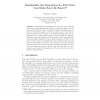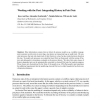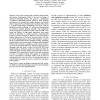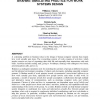850 search results - page 99 / 170 » Modeling synchronous systems in BIP |
APN
2004
Springer
15 years 3 months ago
2004
Springer
Generating the reachability set is one of the most commonly required step when analyzing the logical or stochastic behavior of a system modeled with Petri nets. Traditional “expl...
FUIN
2008
14 years 9 months ago
2008
Abstract. Most information systems that are driven by process models (e.g., workflow management systems) record events in event logs, also known as transaction logs or audit trails...
100
click to vote
SEUS
2008
IEEE
15 years 4 months ago
2008
IEEE
Abstract— This paper presents SW synthesis using Embedded System Environment (ESE), a tool set for design of multicore embedded systems. We propose a classification of multicore...
IJMMS
1998
14 years 9 months ago
1998
A continuing problem in business today is the design of human-computer systems that respect how work actually gets done. The overarching context of work consists of activities, wh...
MST
2011
14 years 4 months ago
2011
In this paper we generalize the Continuous Adversarial Queuing Theory (CAQT) model [5] by considering the possibility that the router clocks in the network are not synchronized. W...




